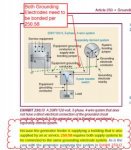We have a project were we are installing an outdoor diesel generator for an optional standby system. Generally we use 4-Pole automatic transfer switches so the generator is considered a separately derived system (SDS). Because it will be a SDS, we will install a grounding electrode at the generator. Because of the required concrete work, this will be a concrete encased electrode (Ufer) and GEC will be installed per 250.30.
The question I have is if we need to connect this new grounding electrode to the existing grounding electrodes within the building per 250.52 & 250.58?
The question I have is if we need to connect this new grounding electrode to the existing grounding electrodes within the building per 250.52 & 250.58?



